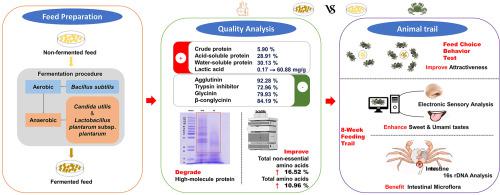Animal Nutrition ( IF 6.3 ) Pub Date : 2023-04-10 , DOI: 10.1016/j.aninu.2023.04.002 Weibo Jiang 1 , Xiaoyan Jia 1 , Ningjun Xie 1 , Chuang Wen 1 , Shuo Ma 1 , Guangzhen Jiang 1 , Xiangfei Li 1 , Cheng Chi 1 , Dingdong Zhang 1 , Wenbin Liu 1

|
Normally, proper fermentation can be an efficient and widely used method to improve feed quality in animal rearing; however, the studies on crustaceans, especially Eriocheir sinensis, remain limited. This study aimed to investigate whether feed fermentation could meliorate dietary nutritional value and benefit E. sinensis rearing. First, non-fermented feed (NFD) and fermented feed (FD) were produced and assessed, respectively. Then, the “Y” maze feed choice behavior test (180 times; 30 times, 6 rounds) was conducted to assess the attractiveness of these 2 feeds for crab. Finally, a total of 80 crabs (44.10 ± 0.80 g) were randomly assigned into 2 groups with 4 replicates, and fed the experimental diets for 8 weeks to evaluate the effects of each feed on growth, antioxidant capacity, meat flavor, and intestinal microbiota. In this study, FD showed higher levels of crude protein (P < 0.01), soluble protein (P < 0.01), amino acids (P < 0.05), lactic acid (P < 0.001), and lower levels of crude fiber (P < 0.05) and antinutritional factors (agglutinin, trypsin inhibitor, glycinin, and β-conglycinin) (P < 0.001) than NFD. Additionally, FD was more attractive to crabs than NFD (P < 0.01) and it stimulated the appetite of crabs more than NFD (P < 0.05). The growth performance, feed efficiency, and digestive enzyme activity of FD-fed crabs were significantly higher than those of NFD-fed crabs (P < 0.05). The electronic sensory measurements and free amino acid profiles revealed that the FD diet had positive impacts on the meat flavor of crabs, particularly in “sweet” and “umami” tastes. Moreover, the antioxidant capacity of FD-fed crabs was significantly higher than that of NFD-fed crabs (P < 0.05). Fermented feed also affected the diversity and composition of intestinal microflora. The functional prediction of microbial communities showed that crabs fed FD had a better microecological environment in the intestine. In conclusion, the fermentation of aquafeed could be an effective approach to enhance feed quality and therefore benefit E. sinensis rearing.
中文翻译:

水产饲料发酵可改善中华绒螯蟹(Eriocheir sinensis)的日粮营养质量,并有利于摄食行为、肉味和肠道微生物群
通常,适当的发酵是提高动物饲养饲料质量的有效且广泛使用的方法;然而,对甲壳类动物特别是中华绒螯蟹的研究还很有限。本研究旨在探讨饲料发酵是否可以改善饲料营养价值并有利于中华鲟的饲养。首先,分别生产和评估非发酵饲料(NFD)和发酵饲料(FD)。然后进行“Y”迷宫饲料选择行为测试(180次;30次,6轮),评估这2种饲料对螃蟹的吸引力。最后,将80只螃蟹(44.10±0.80 g)随机分为2组,每组4个重复,饲喂实验饲料8周,评价每种饲料对生长、抗氧化能力、肉味和肠道菌群的影响。在本研究中,FD显示粗蛋白(P <0.01)、可溶性蛋白(P <0.01)、氨基酸(P <0.05)、乳酸(P <0.001)水平较高,粗纤维( P < 0.001)水平较低。0.05)和抗营养因子(凝集素、胰蛋白酶抑制剂、大豆球蛋白和β-伴大豆球蛋白)(P < 0.001)均高于 NFD。此外,FD比NFD对螃蟹更具吸引力(P < 0.01),并且比NFD更能刺激螃蟹的食欲(P < 0.05)。FD饲喂河蟹的生长性能、饲料效率和消化酶活性均显着高于NFD饲喂河蟹(P < 0.05)。电子感官测量和游离氨基酸谱显示,FD 饮食对螃蟹的肉味有积极影响,特别是“甜味”和“鲜味”。此外,FD喂养的螃蟹的抗氧化能力显着高于NFD喂养的螃蟹(P < 0.05)。发酵饲料还影响肠道菌群的多样性和组成。微生物群落功能预测表明,饲喂FD的螃蟹肠道内微生态环境较好。总之,水产饲料发酵是提高饲料质量的有效途径,有利于中华鲟的养殖。


























 京公网安备 11010802027423号
京公网安备 11010802027423号